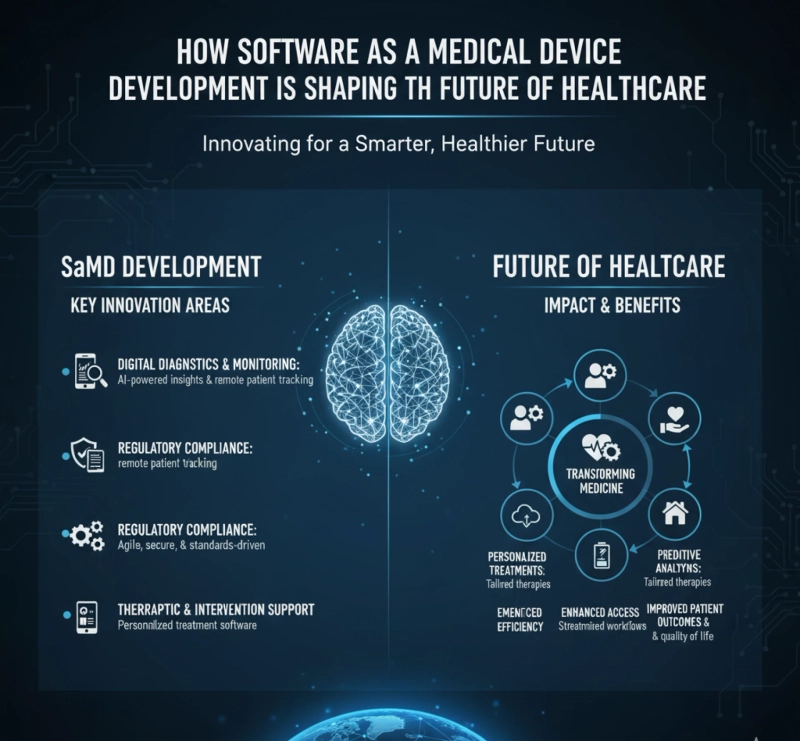The healthcare industry is experiencing a digital transformation, with Software as a Medical Device (SaMD) development emerging as a key driver of innovation. SaMD refers to standalone software designed to perform medical functions without being part of a physical device. From diagnostics and monitoring to therapy management, SaMD development is enabling safer, more efficient, and more personalized healthcare solutions. Understanding the process, benefits, and challenges of SaMD development is essential for healthcare providers, technology companies, and regulators aiming to deliver advanced digital health products.
What Is Software as a Medical Device Development?
Software as a Medical Device development involves designing, building, testing, and maintaining software that serves a medical purpose independently of hardware. Unlike embedded software, which is integrated into a physical medical device, SaMD operates on computers, mobile devices, or cloud platforms to support clinical decisions, patient monitoring, or therapeutic interventions.
Key objectives of SaMD development include:
1. Ensuring accuracy and reliability in medical functions.
2. Maintaining regulatory compliance with standards such as FDA, ISO 13485, and IEC 62304.
3. Delivering user-friendly interfaces for clinicians and patients.
4. Enabling scalability and interoperability across healthcare systems.
SaMD development combines clinical expertise, regulatory knowledge, and advanced software engineering to create solutions that directly impact patient care.
Importance of SaMD Development in Healthcare
The rise of digital health, telemedicine, and connected devices has made SaMD development increasingly important. Some of its key benefits include:
1. Enhanced Patient Care
SaMD tools provide clinicians with real-time insights, predictive analytics, and diagnostic support, enabling faster and more accurate medical decisions.
2. Remote Monitoring and Telehealth
With SaMD, patients can be monitored at home, reducing hospital visits and improving chronic disease management.
3. Cost Efficiency
By automating clinical workflows and minimizing the need for physical interventions, SaMD helps healthcare providers reduce operational costs.
4. Regulatory Compliance
Structured SaMD development ensures adherence to international standards, maintaining safety, reliability, and quality assurance.
5. Innovation and Scalability
SaMD allows the rapid deployment of new features, AI algorithms, and data-driven enhancements without requiring hardware changes.
Stages of Software as a Medical Device Development
A systematic approach is essential to deliver reliable and compliant SaMD solutions. Key stages include:
1. Requirement Analysis
Understanding clinical needs, intended use, user requirements, and regulatory considerations.
2. Design and Architecture
Developing software architecture, user interfaces, data flows, and ensuring system scalability and security.
3. Development and Coding
Writing code following best practices, using secure and maintainable programming standards.
4. Verification and Validation
Testing the software rigorously to ensure it meets functional, clinical, and regulatory requirements.
5. Regulatory Submission
Preparing documentation, risk assessments, and validation reports for approval by regulatory authorities.
6. Deployment and Maintenance
Implementing the software in clinical environments, providing updates, monitoring performance, and ensuring continuous compliance.
Technologies Enabling SaMD Development
SaMD development leverages several advanced technologies:
· Artificial Intelligence (AI) and Machine Learning (ML): AI-driven algorithms support diagnostics, predictive analytics, and decision-making.
· Cloud Computing: Provides scalable storage, remote access, and seamless updates.
· Internet of Medical Things (IoMT): Connected devices feed real-time patient data into SaMD platforms.
· Natural Language Processing (NLP): Extracts actionable insights from unstructured clinical data, such as doctor notes or EHRs.
· Cybersecurity Frameworks: Protect sensitive patient data and ensure compliance with HIPAA and GDPR regulations.
These technologies help developers create intelligent, secure, and compliant SaMD solutions.
Applications of SaMD Development
SaMD development has broad applications across healthcare:
1. Diagnostic Software: AI-powered tools that analyze medical images, lab results, or patient data for early disease detection.
2. Chronic Disease Management: Apps and platforms that monitor patients with diabetes, hypertension, or cardiovascular disorders.
3. Telemedicine and Virtual Care: Tools enabling remote consultations, symptom assessments, and patient engagement.
4. Predictive Analytics: Algorithms forecasting disease progression, risk of readmission, or complications.
5. Therapeutic Support: Software guiding treatment protocols, medication management, or rehabilitation exercises.
These applications demonstrate how SaMD is transforming healthcare delivery, making it more accurate, proactive, and patient-centered.
Challenges in SaMD Development
While SaMD offers significant benefits, development comes with challenges:
· Regulatory Complexity: Compliance with international regulations requires extensive documentation and validation.
· Data Security Risks: Protecting patient information against cyber threats is critical.
· Interoperability: SaMD must integrate smoothly with existing healthcare IT systems and devices.
· Algorithm Bias: Ensuring AI models are trained on diverse and accurate datasets to prevent errors.
· User Adoption: Training clinicians and patients to use the software effectively.
Overcoming these challenges requires collaboration between software engineers, clinicians, and regulatory experts.
Future Trends in SaMD Development
The future of Software as a Medical Device development is shaped by emerging technologies and evolving healthcare needs:
· AI-Driven Diagnostics and Decision Support: More precise, automated clinical decision-making.
· Remote Patient Monitoring and Telehealth Expansion: Delivering care beyond traditional clinical settings.
· Personalized Medicine: Software tailored to patient-specific genetics, behaviors, and medical history.
· Integration with Wearables and IoT Devices: Continuous, real-time patient data collection for proactive care.
· Explainable AI (XAI): Transparent algorithms providing clinicians with understandable insights for trust and accountability.
These trends indicate a move toward more intelligent, connected, and patient-centered healthcare solutions.
Conclusion
Software as a Medical Device development is transforming the healthcare industry by enabling intelligent, compliant, and scalable digital health solutions. From AI-powered diagnostics to remote patient monitoring, SaMD provides clinicians with the tools they need to improve outcomes, reduce costs, and enhance patient experiences.
As the healthcare sector continues to embrace digital transformation, investing in high-quality SaMD development will be crucial for companies and providers aiming to deliver innovative, reliable, and future-ready healthcare solutions. In this era of connected and intelligent care, SaMD is not just software—it is a vital component of modern medicine.



